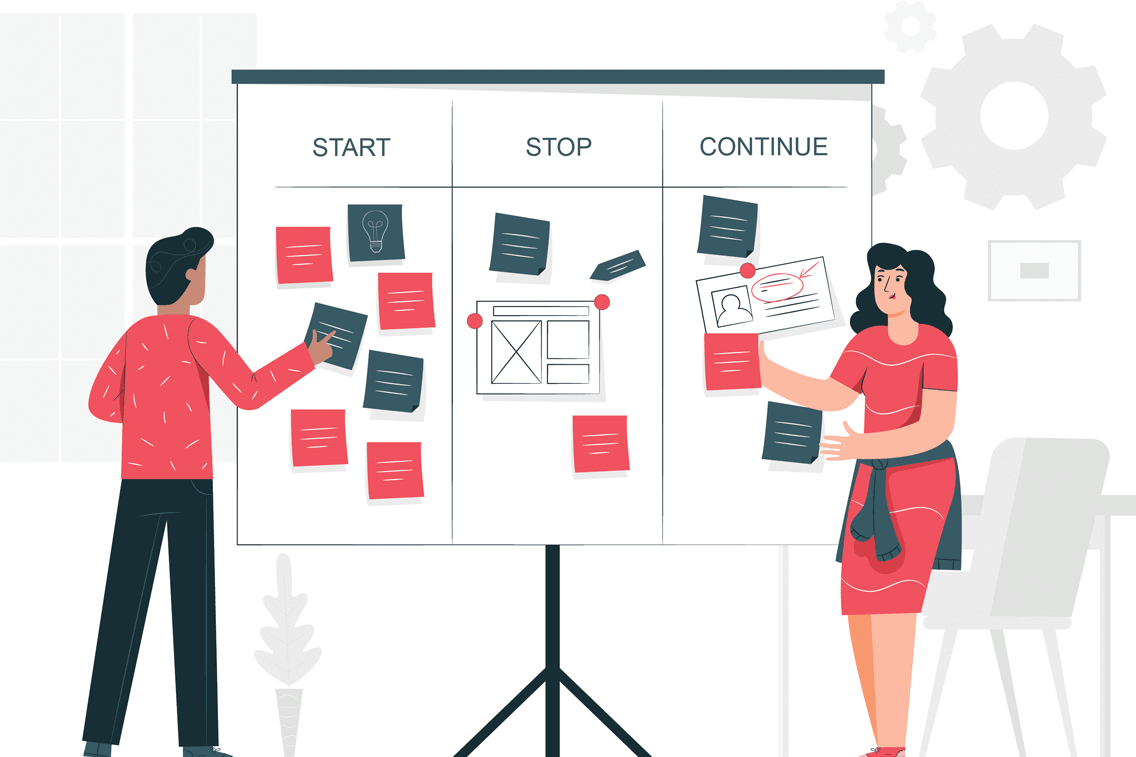4 FRESH IDEAS TO MAKE RETROSPECTIVES MORE ENGAGING
Once you have an understanding of what makes for a good retrospective — and you put those elements into place — it’s easy to get comfortable and stick to a set meeting structure. In our experience, the best retrospectives are ones that continue to shake things up over time. In this blog post, we’ll review four fresh ideas to make your retrospectives more fun and engaging.
1. Use Different Formats
Instead of sticking to a more traditional retrospective format, try coming up with different ways to structure your sessions. Encourage experimentation, but remember to still come up with actionable takeaways. Keep looking for ways to improve each other and make things better.
For example, your classic retrospective format involves identifying what worked, what didn’t work, what could have been better, and actionable ideas for improvement. Atlassian outlines a few different retrospective templates on its website based on alternative formats.
Some of the different ways you can organize your information include:
- Start, stop, continue: Have your team identify what they should start doing, what they should stop doing, and what they should continue doing. The goal is idea generation.
- Mad, sad, glad: Have your team identify what made them mad, what made them sad, and what made them glad. The goal is to understand your team’s emotional health.
- Sailboat: Your team is the boat. The wind represents things that propel the team forward. The anchor represents things delaying the team. The rocks represent risks. And an island is the goal. The goal is to define your vision as a team and identify any problems.
- Liked, learned, lacked, longed for: Liked, learned, lacked, and longed for represent four different categorization sections. The goal is to assess the situation in a factual way.
- Quick retrospective: Ask your team to identify what was good and what was bad about the previous sprint. Then begin brainstorming new ideas and actionable takeaways.
When you structure your retrospective in a different way, it can inspire new ideas. For even more format inspiration, we also enjoyed these creative retrospective ideas from Parabol.
2. Develop Different Themes
Consider incorporating a different theme for each retrospective. This strategy is different from using different formats because you can try out multiple themes based on similar formats.
Examples of two fun themes for your retrospective include:
- PAC-MAN: This retrospective theme gets its inspiration from the classic arcade game. Pac-Man represents what went well. The ghosts represent blockers. The power pellets are any techniques that proved successful and extra lives are actionable ideas.
- Three Little Pigs: This retrospective theme uses the Three Little Pigs children’s story to guide the reflection and ideation process. The three pigs built their houses out of straw, sticks, and bricks. Straw represents weaknesses. Sticks represent things that went OK to improve on. Bricks represent things that went well. Develop action items at the end.
If you find a particular theme doesn’t work out as planned, you can either go back to your tried and true formula for the next time or try out another one. You can also make note of your favorite themes and eventually have an idea bank of themes to choose from when short on time.
3. Switch Up Who Leads
While it may be tempting to have designated roles for every retrospective, switching up who leads the conversation can actually make each session feel fresh and exciting. Different team members leading the retrospective may actually encourage different feedback, as well.
4. Get Creative With Visual Aids
Using visual aids can help your team view successes and challenges from a different perspective. Highlight progress toward goals or areas of improvement. You can also use visual aids to reflect on what didn’t work so well during a sprint. Visual aids should be simple and intuitive.
While you can use things like graphs and charts to highlight relevant data, we’re more talking about using a whiteboard — physical or virtual — to capture thoughts and ideas from your team. You can go the route of colorful notecards or even use simple drawings to get the job done.
Developing a fun theme also can be inspiration for the visual aid you use.
Get Creative With Your Retrospectives
There really are no limits to how you can present a retrospective. Simple is typically best. But there are all kinds of fun formats and theme ideas you can experiment with. The most important thing is to know your audience. Get a feel for what they enjoy and use it as inspiration!
Recent posts
-
JSMMar 12, 2024
-
DevOpsMar 06, 2024
-
ITIM & AgileFeb 16, 2024



